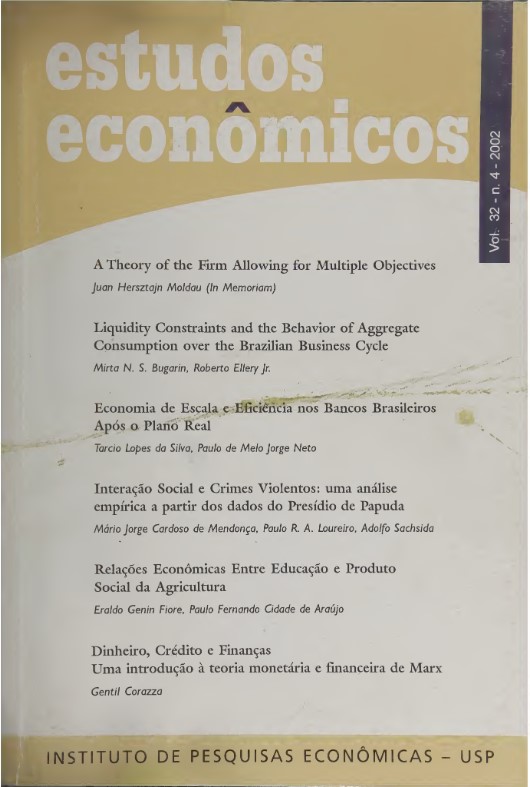Liquidity constraints and the behavior of aggregate consumption over the Brazilian Business Cycle
DOI:
https://doi.org/10.11606/1980-53573242mbrjPalavras-chave:
Consumo de bens não-duráveis, Modelo de ciclos reais de negócio, VolatilidadeResumo
Uma caracteristica marcante no ciclo econômico brasileiro e a alta volatilidade do consumo. O desvio padrão do ciclo do consumo de bens não duráveis, no período entre 1970 e 1998, e igual a 5,26%, quase igual ao do produto (5,57%). Um dos motivos pelos quais os modelos de ciclos reais de negócios não conseguem reproduzir este fato pode ser a existência de restrições ao crédito encontrada pelos consumidores. Este trabalho apresenta uma versão do modelo básico de ciclos reais onde uma fração dos agentes e restrita a consumir toda sua renda a cada período. Simulações numéricas mostram que o modelo com restrição ao crédito e capaz de reproduzir a alta volatilidade da série de consumo, porém o modelo subestima a correlação entre investimento e produto.
Downloads
Referências
BARRETO, Flávio; OLIVEIRA, L. G. Aplicação de um modelo de gerações superpostas para a reforma da previdência no Brasil: uma análise de sensibilidade no estado estacionario. Anais do XVII Encontro Brasileiro de Econometria, 1995.
CARMICHAEL; KEITA; SAMSON. Liquidity constraints and business cycle in developing countries. Review ofEconomic Dynamics, v. 2, p. 370-402, 1999.
CAVALCANTI, Carlos. Intertemporal substitution in consumption: an empirical investigation for Brazil. Revista de Econometria, 1993.
COOLEY, Thomas E; PRESCOTT, Edward C. Economic growth and business cycles. In: COOLEY, Thomas E (ed.), Frontiers of business cycle research. Princeton: Princeton University Press, 1995.
ELLERY JR., R.; GOMES, V.; SACHSIDA, A. Business cycles fluctuations in Brazil. Revista Brasileira de Economia, v. 56, n. 2, p. 249-308, 2002.
FAEMER, Roger. The macroeconomics ofself-fulfillingprophecies. The MIT Press, 1993.
FRIEDMAN, Milton. A theory of the consumption function. Princeton; Princeton University Press, 1957.
GLEIZER, Daniel. Saving and real interest rates in Brazil. Revista de Econometria, 1991.
GOMES, Victor; BUGARLN, Mirta; ELLERY JR., Roberto. Short and long run implications of the Brazilian capital stock and income estimates. Sao Paulo: Latin American Meeting of the Econometric Society, 2002.
HANSEN, Gary D.; PRESCOTT, Edward C. Recursive methods for computing equilibria ofbusiness cycle models. In: COOLEY, Thomas E (ed.), Frontiers of business cycle research. Princeton: Princeton University Press, 1995.
HODRICK, Robert J.; PRESCOTT, Edward C. Postwar US business cycles: an empirical investigation. Journal ofMoney, Credit and Banking, v. 29, n. 1, p. 1-16, February 1997.
HALL, Robert. Stochastic implications ofthe life-cycle permanentincome hypothesis: theory and evidence Journal of Political Economy, 1978.
IMROHOROGLU, Ayse. Cost of business cycles with indivisibilities and liquidity constraints Journal of Political Economy, 1989.
ISSLER, João V; ROCHA, Fernando. Consumo, restrição de liquidez e bem-estar no Brasil. Brazilian Journal of Applied Economics, v. 4, n. 4, p. 637-665, December 1999.
JUDD, Kenneth. Numerical methods in economics. The MIT Press, 1998.
KANCZUK, Fabio; FARIA, Francisco. Ciclos reais para a indústria brasileira? Estudos Econômicos, v. 30, n. 3, p. 335-350, jul./set. 2000.
KYDLAND, Finn E.; PRESCOTT, Edward C. Time to build and aggregate fluctuations. Econometrica, v. 50, n. 6, p. 1345-1369, November, 1982.
NOVALES, A.; DOMINGUEZ, E.; PEREZ, J.; RUIZ, J. Solving nonlinear rational expectations models by eigenvalue-eigenvector decompositions. In MARIMON, Ramon; SCOTT, Aidrew (eds.),
Computational methodsfor the study of dynamic economies. Oxford: Oxford University Press, 1999.
PRESCOTT, Edward C. Theory ahead of business cycle measurement Federal Reserve Bank of Minneapolis Quarterly Review, v. 10, n. 4, p. 9-22, Fall 1986.
REIS, Eustaquio J., ISSLER, João V; BLANCO, E; CARVALHO, L. Renda permanente e poupança precaucional: evidência empírica para o Brasil no passado recente. Pesquisa e Planejamento Econômico, 1998.
VAHID, Farshid; ENGLE, Robert. Common trends and common cycles. Journal of Applied Econometrics, v. 8, n. 4, p. 341-360, 1993.
VAL, Paulo K. Modelos de ciclos reais de negócios aplicados a economia brasileira: um estudo de matching. EPGE/FGV, 1999.
Downloads
Publicado
Edição
Seção
Licença
Copyright (c) 2002 Mirta N. S. Bugarin, Roberto Ellery Júnior

Este trabalho está licenciado sob uma licença Creative Commons Attribution-NonCommercial 4.0 International License.
A submissão de artigo autoriza sua publicação e implica o compromisso de que o mesmo material não esteja sendo submetido a outro periódico.
A revista não paga direitos autorais aos autores dos artigos publicados.





 Atualizado em 14/08/2025
Atualizado em 14/08/2025